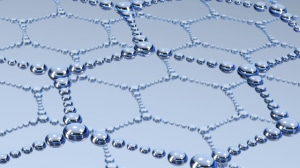Smart Grid Water Networks: Part of the Water Efficiency Arsenal
 The impacts of global climate change have driven governments, businesses, and communities around the world to consider efficiency and conservation in all areas of our lives, rethink business plans, and reconsider the relationships between people and resources to create a more sustainable future.
The impacts of global climate change have driven governments, businesses, and communities around the world to consider efficiency and conservation in all areas of our lives, rethink business plans, and reconsider the relationships between people and resources to create a more sustainable future.
Nowhere is this focus on sustainability clearer than in water utilities. Faced with an aging distribution infrastructure in need of overhauling, growing populations, and shrinking supply, utilities are struggling with developing innovative, yet cost effective, ways to maintain and improve already maxed out water systems.
Just as smart metering has shed light on our energy use, utilities, environmental groups, and governments are beginning to look to smart metering to help with water conservation.
What is Smart Networks and Metering? AMI vs. AMR
A smart water network – or smart grid for water – may be the next big thing as communities around the world come to terms with water scarcity and the need for water conservation. The crux of the smart water network is advanced metering infrastructure (AMI) technology. AMI can provide a remote and constant two-way communication link between utilities, meters and consumers via the usual communications technologies (broadband, fiber optic cable, wireless, etc.).
As a key component of a smart water network, smart water meters integrated with sensing technologies give water utilities advanced tools for more efficiently measuring water consumption and providing water customers with data to help them monitor their water usage and reduce costs. Often known as “smart lite”, advanced meter reading (AMR) technology, one-way information gathering from customer to utility is seen as a cost effective approach to accurate billing and leakage. This solves the bulk of many water utility needs.
Benefits – Knowledge is Power
Smart metering increases the information available to the customer which helps them better understand and curb their water use.
Preliminary investigation indicates that customers with displays are more likely to use less water. However, installing monitors at each customer site may come with a price tag water utilities find difficult to afford. As a result, many elect less expensive ways to provide consumption details, such as Web sites or printouts enclosed with bills. Although surveys indicate that customers prefer the on-site display, web portals are another effective method to link concerned customers to information on how to lower consumption and/or bills.
Smart metering also delivers valuable data to utilities. For example, utilities can use the data collected to detect customer-premises leaks from their end. Utilities could also use the technology to identify possible leaks at commercial and industrial properties with round-the-clock water use.
More over, according to UN-Water, approximately 8% of the world’s energy production is used for pumping, treating and transporting water. Saved water means saved energy—a double benefit—and a better future for generations to come.
Smart water networks have evolved to the point where they can reliably produce the benefits described above, within very reasonable payback periods. While many jurisdictions are contemplating extreme measures – water rationing, desalinization plants, building canals hundreds of miles long – smart water networks can reclaim 20% to 40% of water that is typically lost to leaks and theft, according to SmartGridNews.com.
So What’s the Catch?
While there are increasing studies looking at the benefits and uses of smart metering, utilities are not overlooking the price tag that comes along with the technology. Additionally, the jury is still out whether or not customers will embrace yet another judgement on their lifestyle. In the early days of energy metering, some utilities paid big bucks to have local energy use comparisons printed on customer bills. The frowning face on high energy-use customers’ bills did very little to encourage conservation and win over utilities good intentions with the public.
There are still many challenges in network understanding and costs analysis that make smart water networks slow in development. Despite the many benefits, justifying the implementation of the technology to support smart metering will require cooperation and support from local and regional governments, communities, and above all, customers.
Careful planning and close scrutiny of all the costs associated with implementing a smart water network will allow utilities to plan for scaleable implementation of this technology.
